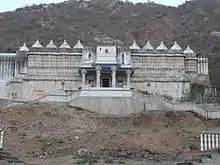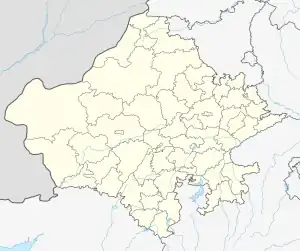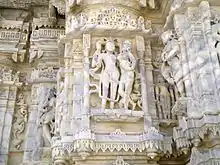Mirpur Jain Temple
Mirpur Jain Temple is situated in Mirpur, a fortified village in the Sirohi district of Rajasthan, India. The village has four Jain temples.
| Mirpur Jain Temple | |
|---|---|
 Mirpur Jain Temple | |
| Religion | |
| Affiliation | Jainism |
| Deity | Parshvanatha |
| Governing body | Seth Kayanji Parmanandji Trust, Sirohi |
| Location | |
| Location | Mirpur, Sirohi, Rajasthan, India |
 Location within Rajasthan | |
| Geographic coordinates | 24.857469°N 72.806396°E |
| Architecture | |
| Completed | 9th Century |
| Temple(s) | 4 |
| Part of a series on |
| Jainism |
|---|
 |
History
Mirpur Jain Temple was built in the 9th century AD, during the reign of the Rajputs. The Mirpur temple is generally thought to be the oldest marble monument in Rajasthan. It is devoted to the 23rd Jain tirthankara, Pārśva.[1] The temple was destroyed by Mahmud Begada in the 13th century, and was rebuilt and renovated in the 15th century. These days only the main temple with its mandapa is standing, high on its pedestal with carved pillars and engraved parikrama representing every aspect of Indian mythology.[2] The temple has inscriptions which date back to 1162 AD in the temple mentioning history of Hamirgarh. There are seven inscription dating back from 12th to 15th century and latest inscription dating backing to 19th century.[3]
Main temple
Mirpur Jain Temple was built in the 9th century AD. Mirpur Jain temple is architecturally most important building near Sirohi.[4] This temple is also mentioned in the ‘World And Encyclopedia of Art’.[2] The temple is famous for its art and exquisite carvings. The fine carvings of the temple is comparable to the ones in Dilwara temples. The domes, pillars and borders are the features unique to this temple.[3] The murals on the ceiling of temple show unique motifs which are not visible in other Jain temples.[5] The kalamandap is standing on its high pedestrian with carved pillars and engraved parikrama representing every walk of life in Indian Mythology. The indescribable artistry of this temple is famous throughout the world and is considered by many to be unmatched. The ancient art of this temple served as a model for the later Dilwara and Ranakpur temples.[2] This temple belongs to Shvetambara sect of Jainism. The Moolnayak of the temple is a 90 cm tall white colored idol of Lord Parshvanatha called Bhidbhanjan Parshwanathji. This sculpture illustrates Parshwanath's triumph over Kamatha's upsargas, in considerable detail. In this sculpture, Dharanendra raises a hood of 5 cobras to provide shelter for Lord Parshwanath from the relentless storm set into motion by Kamatha. The temple walls and pillars are rich with carvings of floral and geometric designs.[6]
The idols in temple are re-anointed in an annual ceremony. The temple is managed by Seth Shri Kalyanji Paramanandji Pedhi, Sirohi and has a dharmshala, bhojnalya and garden.
Other Temples
- Bhagvan Suparshwanathji Temple: This temple is dedicated to Suparshvanatha. The temple is built in Nagara style. The temple is famous for beautiful glass work of sanctum.[7] This temple belongs to Digamber sect. of Jainism.
- Bhagvan Mahavir Swami Temple: This temple is dedicated to Mahavir Swami. This temple is built in Nagara style. The temple is famous for paintings on dome.[8]
- Bhagvan Shantinath Temple: This is dedicated to Shantinatha. The temple is rich in architecture with an amalgamation of Indo-Persian architecture. It temple has been built in nagara style with decorative pillars and sanctum.[9]
Photo gallery
 Main idol of Parshwanath
Main idol of Parshwanath The Splendid and elaborate wall of Mirpur Jain Temple
The Splendid and elaborate wall of Mirpur Jain Temple Shikhar of the Mirpur Jain Temple
Shikhar of the Mirpur Jain Temple Carving on a wall
Carving on a wall Pillars at the Mirpur Jain Temple
Pillars at the Mirpur Jain Temple Art Inside Dome at Mirpur Jain Temple
Art Inside Dome at Mirpur Jain Temple Padmavati Mata with her vahan as snake
Padmavati Mata with her vahan as snake A statue of Indra on the walls
A statue of Indra on the walls Idol of Bhagvan Mahavir Swami Temple dating back 13th century
Idol of Bhagvan Mahavir Swami Temple dating back 13th century Art at the Entrance door to the main Shrine
Art at the Entrance door to the main Shrine Megrath Bhav of Bhagvan Shantinathji
Megrath Bhav of Bhagvan Shantinathji
See also
References
Citation
- Hendrix & Okeja 2018, p. 508.
- RTDC.
- Mehta 1970, p. 105.
- Titze & Bruhn 1998, p. 172.
- Titze & Bruhn 1998, p. 173.
- IGNCA, p. 1.
- IGNCA & Suparashwnath temple, pp. 1–3.
- IGNCA & Shri Mahavir swami temple, pp. 1–3.
- IGNCA & Shantinath temple, pp. 1–3.
Source
- Hendrix, Scott E.; Okeja, Uchenna (2018), The World's Greatest Religious Leaders: How Religious Figures Helped Shape World History, vol. 2, ABC-CLIO, ISBN 9781440841385
- Mehta, Jodh Sinha (1970), Abu to Udaipur (Celestial Simla to City of Sunrise), Motilal Banarsidass
- Titze, Kurt; Bruhn, Klaus (1998), Jainism: A Pictorial Guide to the Religion of Non-Violence (2 ed.), Motilal Banarsidass, ISBN 978-81-208-1534-6
- RTDC. "Sirohi tourist places". Rajasthan Tourism Development Corporation.
- Indira Gandhi National Centre for the Arts
- IGNCA. "Shree Parashwnath Bhagwan Ka Mandir" (PDF). Indira Gandhi National Centre for the Arts.
- IGNCA. "Shree Mahaveer Swami jee Mandir" (PDF). Indira Gandhi National Centre for the Arts.
- IGNCA. "Shree Suparashwnath Bhagwan Ka Mandir" (PDF). Indira Gandhi National Centre for the Arts.
- IGNCA. "Shree Shanti Nath Bhagwan Ka Mandir" (PDF). Indira Gandhi National Centre for the Arts.